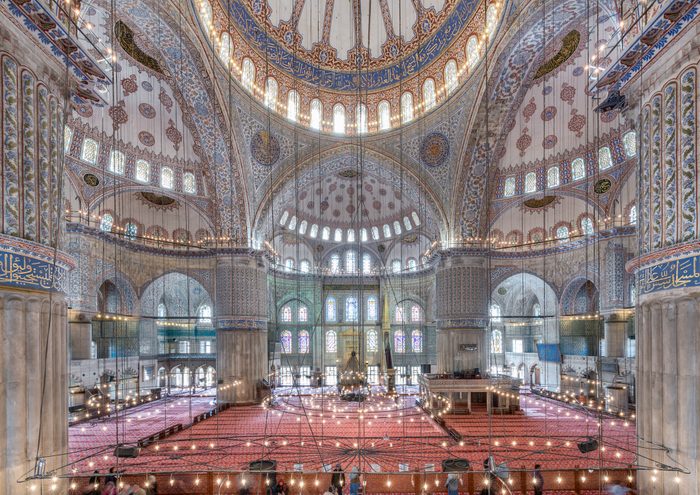
Awesome creations
These amazing structures seem too detailed, too complex, too intricate, or too big to have been built by people, particularly those made long ago before machines existed to aid in their creation. Yet the world’s most beautiful buildings and statues stand as a testament to human capability and innovation. Some cities have more than one—we could do a whole story on Paris alone—but we searched the world to find the structures that best inspire, mystify, and leave us awestruck. We might not be able to see them all in real life, but luckily we can take a trip around the globe to visit them virtually.
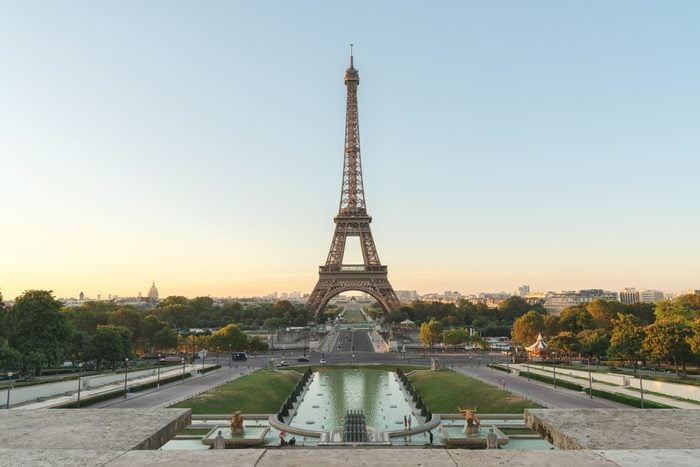
The Eiffel Tower
Paris has an abundance of beautiful sites: Notre Dame, the Louvre, the Arc de Triomphe, and many more. But the Eiffel Tower stands as the iconic landmark of France’s capital—although it’s only been part of the city for 131 years. Designed by Gustave Eiffel and built in just over two years, which was considered record speed at the time, the 1,063-foot-tall iron tower was created for the 1889 World’s Fair. “Before coming together at the high pinnacle, the uprights appear to burst out of the ground, and in a way to be shaped by the action of the wind,” Eiffel explained of his simple yet elegant design. You can take a virtual tour on the tower’s official website. Check out these mind-blowing Eiffel Tower facts you never heard before.
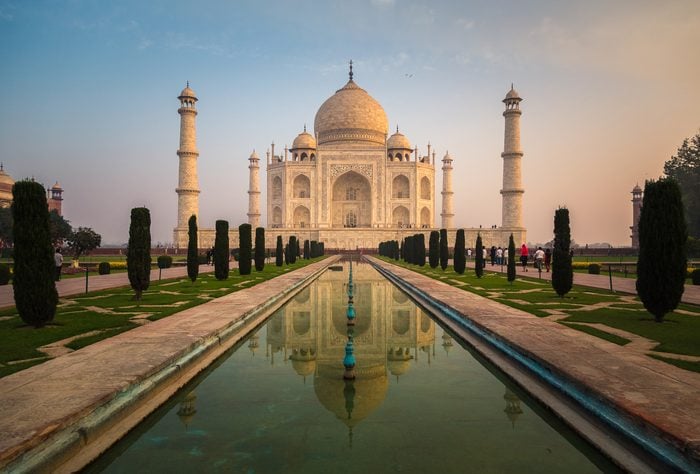
The Taj Mahal
The most beautiful tomb ever created, India’s Taj Mahal looks delicate and refined, decorated with floral and geometric patterns, jewels, calligraphy, and a lace-like design in white marble that reflects the changing colors of the sun in front of a shimmering reflecting pool. Commissioned in 1632 by the Emperor Shah Jahan for his wife Mumtaz Mahal, who had died after giving birth to their 14th child, the mausoleum took 20 years to build. The complex also includes a gateway, mosque, guest house, gardens, and four minarets. Inside the Taj Mahal, the decorations are just as elaborate around the cenotaph, or false tomb, of Mumtaz Mahal; her actual remains are buried below, at ground level.
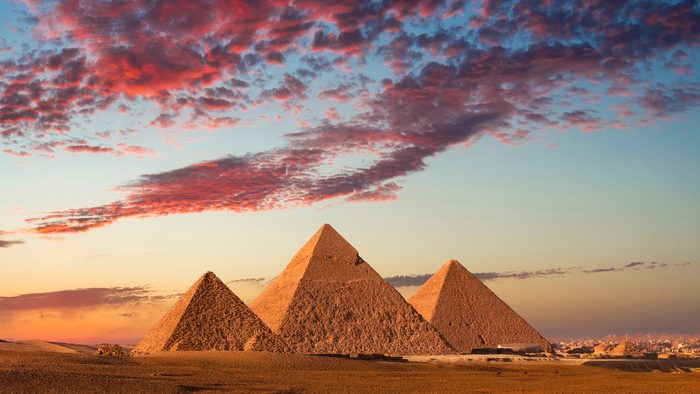
The Pyramids at Giza
The only one of the seven wonders of the ancient world left standing, the three ancient Egyptian pyramids outside of Cairo house the tombs of three pharaohs: Khufu, his son Khafre, and his son Menkaure. Khufu’s is called the Great Pyramid because it’s the biggest, originally reaching 481 feet high. The three amazing structures were built over 70 years from about 2575 to 2465 BC. It’s not completely known how the stone blocks from nearby quarries were lifted into the pyramid shapes, although experts believe they were built by tens of thousands of farmers in the off-season, not slaves. However they were constructed, the work was solid, literally, leaving the impressive pyramids still standing today to astound people just as they did thousands of years ago. Here’s what the pyramids and other famous landmarks look like zoomed out.
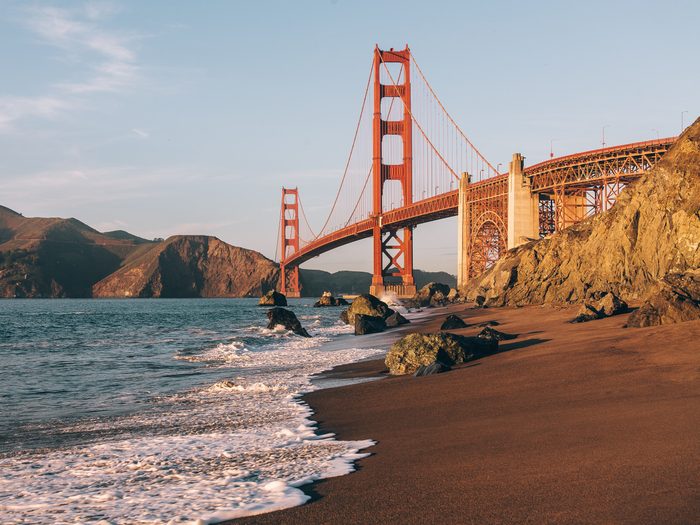
The Golden Gate Bridge
One of the most famous bridges in the world, San Francisco’s Golden Gate Bridge is also perhaps the most breathtaking, spanning the Golden Gate Strait, which links the San Francisco Bay to the Pacific Ocean. In addition to the striking towers and graceful cables of the suspension bridge, its most recognizable aspect is the unique color, called “international orange,” painted on the steel structure. But the color wasn’t an easy sell back in 1933, when the bridge began construction. “The Golden Gate Bridge is one of the greatest monuments of all time,” consulting architect Irving Morrow wrote to convince the bridge’s board of directors. “Its unprecedented size and scale, along with its grace of form and independence of conception, all call for unique and unconventional treatment from every point of view. What has been thus played up in form should not be let down in color.”
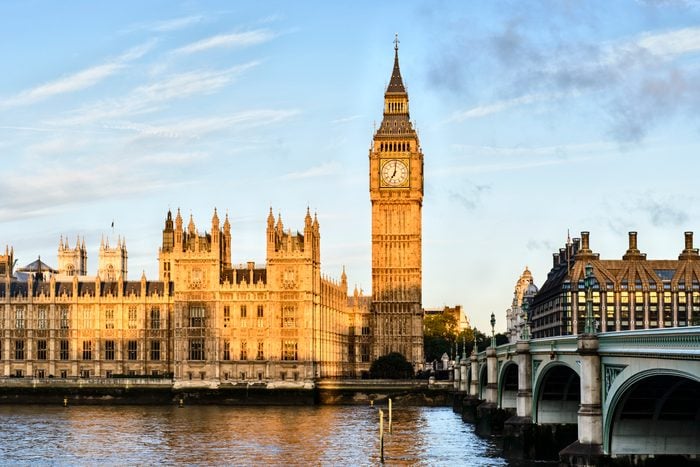
Big Ben and the Houses of Parliament
“Big Ben! Parliament!” Everyone remembers the line from the movie National Lampoon’s European Vacation, and the most famous and beloved clock tower in the world does indeed dominate the London skyline. But it’s actually the bell inside, which weighs more than 13 tons, that is technically called Big Ben; the 315-foot tower is officially Elizabeth Tower.
The original Palace of Westminster, which now houses the British government’s Parliament, was destroyed by fire in 1834. Nearly a decade later, plans were made for a new, Gothic revival-style stone building. Designed by Charles Barry to blend in seamlessly with the surviving medieval buildings, the ornate Parliament building and the tower took 30 years to build.
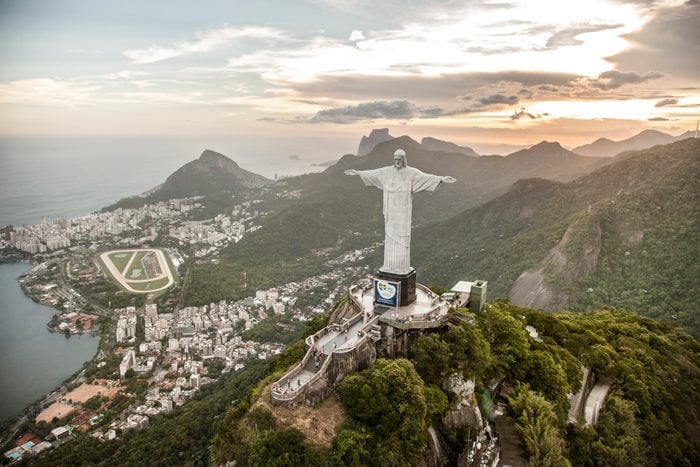
Christ the Redeemer
Keeping watch over Rio de Janeiro, Brazil, this 100-foot-tall Art Deco statue with outstretched arms was completed in 1931 and was the only modern structure voted to be included in the “new seven wonders of the world.” (The other six are the Machu Picchu, the Great Wall of China, Chichen Itza, the Colosseum, Petra—all of which we’ll get to later—and the Taj Mahal). Perched on the top of Corcovado mountain over 2,300 feet above the sea, the beauty of Christ the Redeemer stirs the soul, even among those who aren’t religious. Known locally as Cristo Redentor, the statue is also part of Tijuca National Park, the largest urban rainforest on earth.
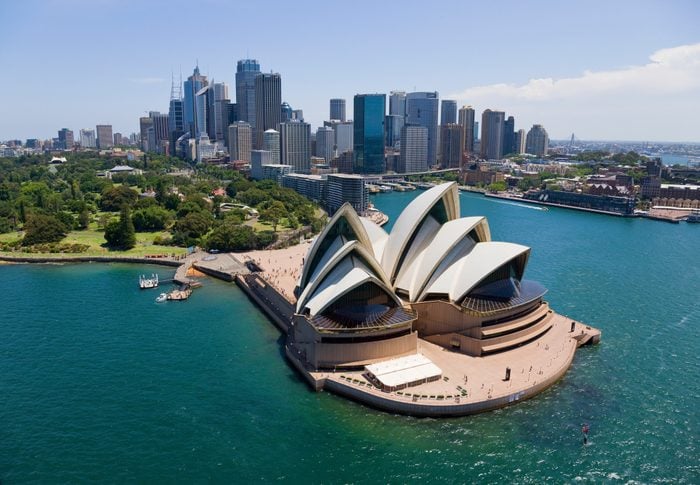
Sydney Opera House
Even if you’ve never been to the opera, you probably recognize the soaring arches of this building over Sydney Harbor, Australia. “It stands by itself as one of the indisputable masterpieces of human creativity, not only in the 20th century but in the history of humankind,” reads a report to UNESCO World Heritage, of which the building is now a member. Designed in the late 1950s and opened in 1973, the vaulted “shells” of the opera house seem to burst out of its harbor-side setting, at once totally modern but also evoking emotion—a dramatic setting to match the drama of the performing arts it houses. Fun fact: 1,056,006 “Sydney tiles,” made of a unique combination of clay and crushed stone, cover the roofs of the shells.
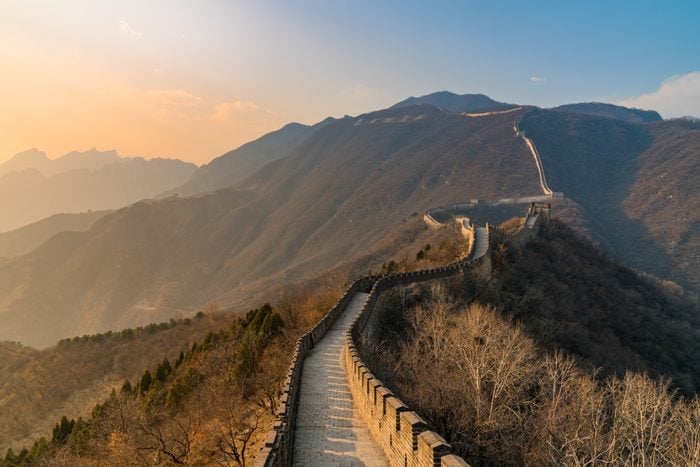
The Great Wall of China
Rolling over the landscape of China, this marvel of architecture blends into the countryside it was built to protect. The Great Wall is not actually one wall, but many branches over thousands of miles. Built over two millennia from the 3rd century BC to the 17th century AD, the military defense system’s length was likely around 13,000 miles. While much less of it remains today, it’s still the longest wall in the world, currently with 2,150 miles of its mainline and about the same number of branches and spurs, according to Guinness World Records. One of mankind’s greatest building achievements, it’s impossible not to be awed by the sight of it.
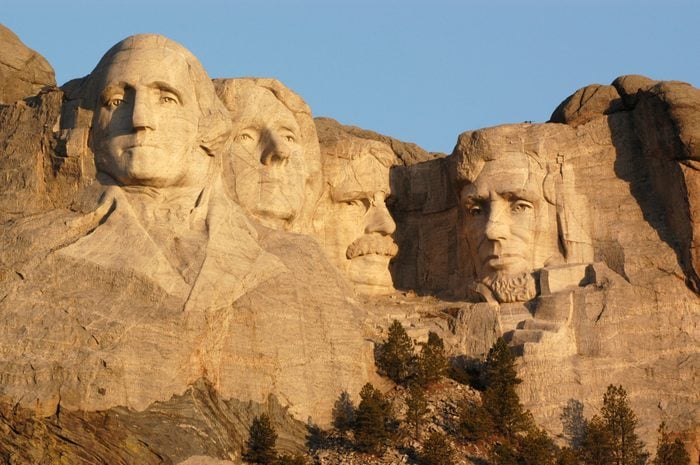
Mount Rushmore
Go “face to face” with four outstanding U.S. presidents—George Washington, Thomas Jefferson, Theodore Roosevelt, and Abraham Lincoln—in this impressive monument to American democracy that seems to burst unexpectedly and majestically from the natural surroundings of South Dakota’s Black Hills. Built from 1927 to 1941, it is an artistic marvel, as well as a feat of engineering and logistics, and the mountain carving took the work of 400 people, many of whom had to literally hang off the mountain to work. According to the National Park Service, 90 percent of the sculpture was carved with dynamite to remove exact amounts of rock in specific places; then the workers would drill into the rock, chip it away for a finer surface, and smooth it out. As for the “why” of carving a mountain, the answer may be similar to the reason for climbing one: Because it’s there. Don’t miss these other historic landmarks in every state.
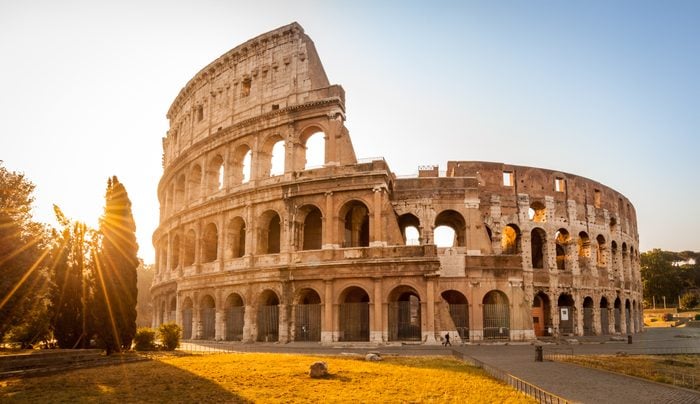
The Colosseum
Every ancient site in Rome is outstandingly beautiful, from the Roman Forum to Palantine Hill to the Pantheon temple to the chariot racetrack Circus Maximus—all reminders of a thriving and vibrant city that existed long ago. But one site represents all the glory that was ancient Rome: the Colosseum. A massive stone amphitheater originally covered in marble and travertine, it was built for the same reasons as the stadiums of today: for sport and entertainment. Holding more than 50,000 spectators, this huge structure took eight years to build, from 72 to 80 AD, though it got a few updates later. As in the movie Gladiator, the entertainment did tend to be on the gory side, with actual gladiators fighting to the death. The arena also held executions and was even flooded for mock naval battles. Imagining these spectacular events at the Colosseum, you can practically hear Gladiator‘s Russell Crowe shouting the line, “Are you not entertained?”
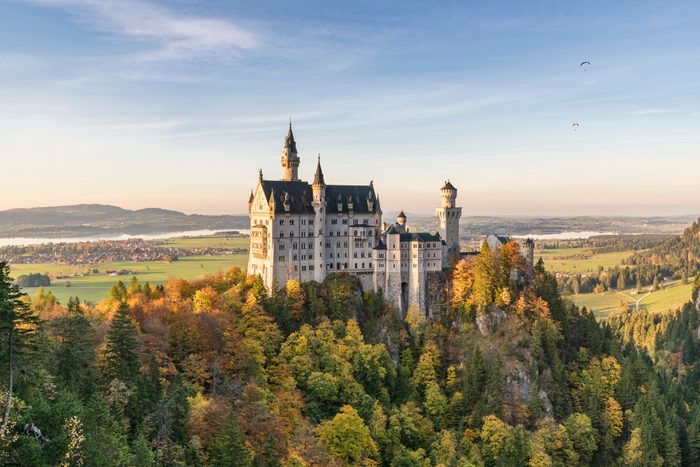
Neuschwanstein Castle
Germany has many gorgeous castles, but the most storybook one has to be Neuschwanstein in Bavaria. Dubbed “the fairy-tale king,” Ludwig II was so inspired by the mountain scenery that he wanted to create a romantic castle-like in the poetry of yore—and he succeeded. Unfortunately, he wouldn’t live to see the completely finished castle, because he was found dead in a lake under mysterious circumstances in 1886; the castle wasn’t mostly completed until 1892. Neuschwanstein seems to float above the surrounding countryside, and though the castle isn’t that high, it gives that impression because of its mountain perch, which also made the construction of the castle difficult. Its beauty, though, is unparalleled. Neuschwanstein Castle is one of the enchanting places that look straight out of a fairy tale.
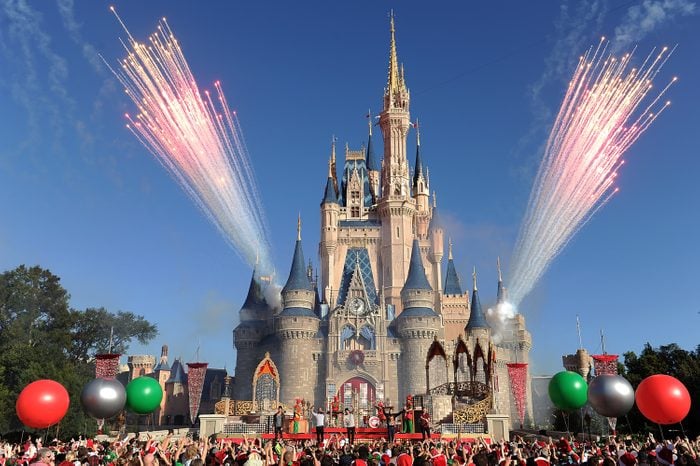
Cinderella’s Castle
If King Ludwig’s castle was built by real royalty fantasizing about fairy tales, Walt Disney’s theme-park castles are a fantasy of that fantasy. Sleeping Beauty Castle in Disneyland, California, was reportedly based on Neuschwanstein after Walt himself took a trip there. But it’s the even more impressive Cinderella’s Castle in Walt Disney World, completed in 1971 and which also resembles Neuschwanstein, that makes our list here. At 189 feet, it’s more than 100 feet taller than Sleeping Beauty’s, with its spires and turrets reaching for the sky. Generations of children and adults alike have been awestruck when they first set eyes on the castle at the end of Main Street, USA. Its soaring towers are surrounded by manicured gardens and a moat—and just inside are gorgeous mosaics of scenes from Disney’s animated classic Cinderella. Here’s what it’s like in the secret hotel suite hidden inside Cinderella’s Castle.
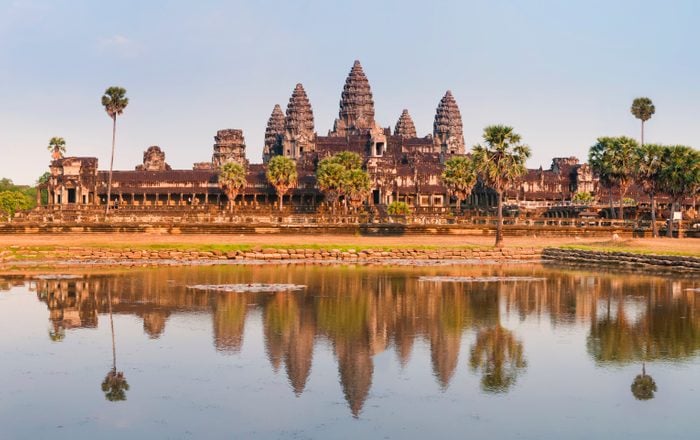
Angkor Wat
This intricately decorated Buddhist (originally Hindu) temple complex in Cambodia became an important pilgrimage site in the Middle Ages. Today, Angkor Wat is revered by those of all religions for the sophisticated construction its of five towers, bas reliefs (3D pictures sculpted into stone), and impressive size as the largest religious monument in the world. In addition, it looks like something out of an adventure movie, as the jungle reclaimed some of the ruins and became one with the architecture—huge trees seem to grow out of the stone itself. The entire Angkor area contains many temples worth exploring, but Angkor Wat is considered the best of the region and even appears on Cambodia’s flag.
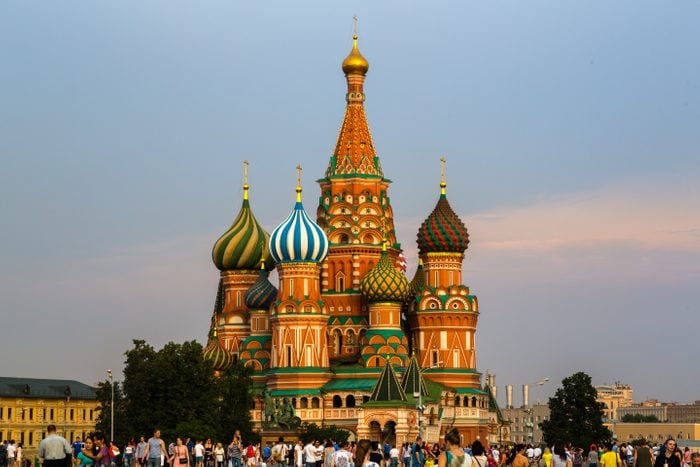
St. Basil’s Cathedral
This vivid church looks like a candy confection with its bright colors, lively patterns, and swirling stripes on domes that look like icing on a cupcake. (They’re actually called onion-shaped domes, but we like cupcake icing better.) Completed in 1561 by Ivan IV, known as Ivan the Terrible, this Russian landmark in Moscow’s Red Square looks in some ways like a confusion of colors and shapes, but the unexpected whimsy of the design is also part of its appeal. The layout is surprisingly orderly, with eight chapels around a central church. Originally, the color scheme may have been white with gold domes; the hues were added 100 years later, giving it a totally unique style.
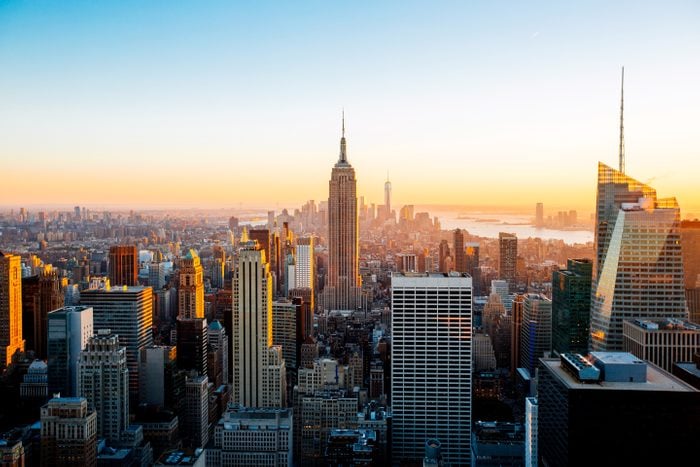
The Empire State Building
This Art Deco skyscraper has entered into legend: King Kong climbed it, lovers marry on Valentine’s Day atop it, it’s the most photographed building in the world, and it’s dominated the New York skyline for nearly 100 years. Opened in 1931, the Empire State Building has 102 floors, stands at 1,250 feet high, and was the world’s tallest building until the World Trade Center was built in 1970. Its sleek silhouette leads up to a glass tube flanked by modern “bird-wing” buttresses that add to the 1920s and ’30s style. At the tube’s top, just before the spire, is the 102nd floor. The only NYC skyscraper to rival its beauty is perhaps the Chrysler Building, which opened in 1930—but the Empire State overtook its rival in both height and popularity to become the top landmark of the city. According to more than 1,000 travel experts, the Big Apple is one of the world’s most beautiful cities.
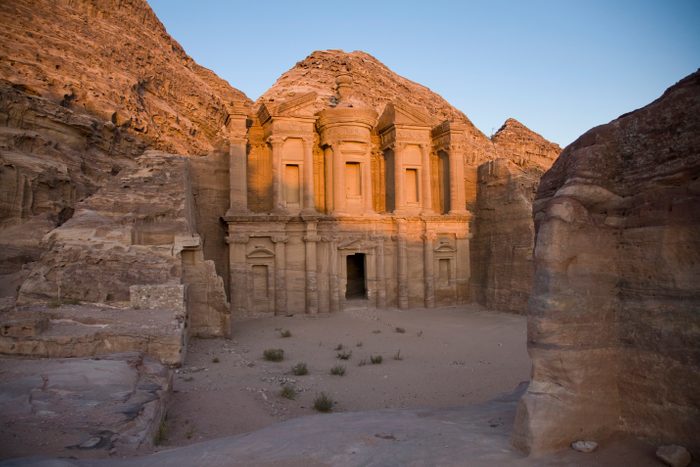
Petra
The ancient “Rose City” of Petra, Jordan, emerges from the reddish-pink sandstone of Jordan’s canyons, and it was an important location on the Middle Eastern trade routes 2,000 years ago. Gradually abandoned after an earthquake, the ruins are now a haunting reminder of that desert kingdom. One of the most incredible structures at Petra is the Treasury, located at the bottom of a gorge, an oddly elegant sight in the natural terrain. Its gorgeous facade became even more famous when it appeared in Indiana Jones and the Last Crusade. The Monastery is another awesome sight, a building carved right out of the rock from which it’s made. Here are another 65 movie and TV filming locations you can actually visit.
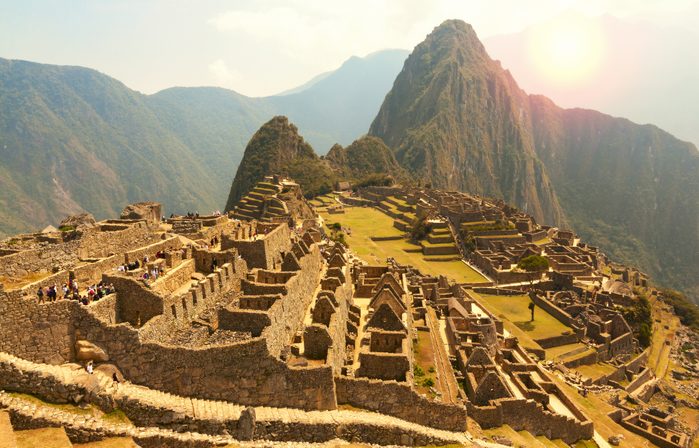
Machu Picchu
More of a city than just a structure, this astonishing Incan complex in Peru was hidden in the midst of a tropical jungle in the Andes mountains 2,430 feet above sea level until it was rediscovered in 1911. Built-in the 15th century, Machu Picchu was abandoned a century later after the Incas were conquered by the Spanish. The main Citadel is surrounded by terraces for farming. Other buildings were used for religious and astronomical purposes, including the Sun Temple, whose window is aligned with the summer solstice. No one knows exactly why Machu Picchu was built, but there’s no doubt it’s a sacred place—and even today we can’t help but be moved by the sight of it. Machu Picchu is one of the historic places that are now abandoned.
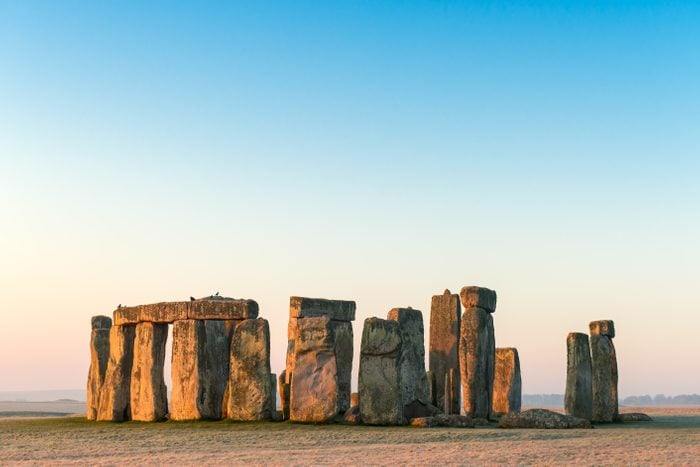
Stonehenge
Another mysterious structure aligned with the solstices, the stone circle of Stonehenge in Wiltshire, England, is bewitchingly alluring. It seems to serve no practical purpose, so it’s assumed to have been made for spiritual reasons. Built 4,500 years ago in the Neolithic Age, we also don’t know exactly how it was constructed, as the stones are up to 30 tons. But its measurements are so precise, it’s clear that the engineers and builders knew what they were doing—and they accomplished it with only rudimentary tools. That it’s still standing today makes it even more awe-inspiring. You can visit virtually with Stonehenge’s live “Skyscape,” which lets you view the sky from inside the stones in real-time, or take a virtual tour.
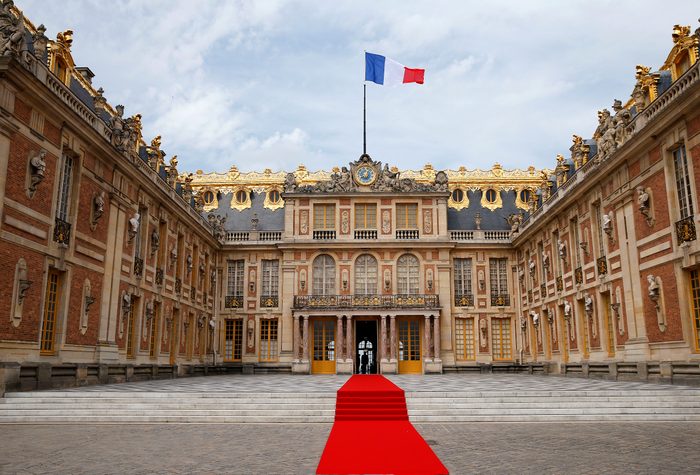
Versailles
A masterpiece of extravagant proportion and exorbitant decadence, the palace of Versailles is one of the grandest royal residences ever to be constructed. Originally built as a hunting lodge just outside of Paris, the chateau was greatly expanded by King Louis XIV, the “Sun King,” beginning in 1661. He constantly added to it until his death in 1715, in a successful attempt to convey his power and wealth, and held huge parties and ceremonies here. The palace’s immense facade is matched by its opulence inside: Its famous 239-foot-long Hall of Mirrors contains 357 of them. The grandeur of Versailles has seldom been equaled, and it also has some of the world’s most unforgettable royal gardens.
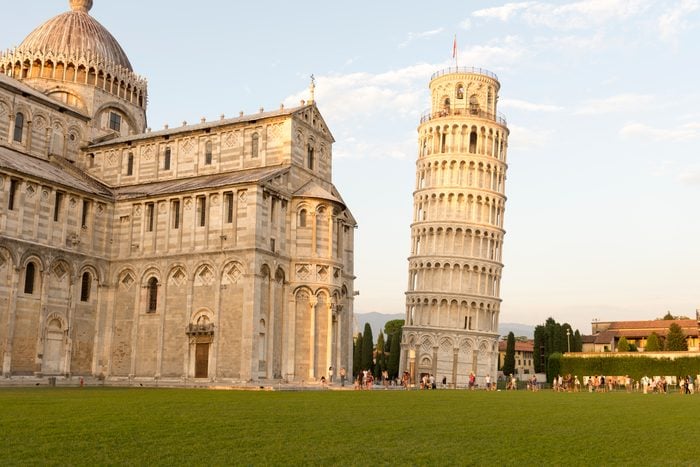
The Leaning Tower of Pisa
This bell tower owes some of its unique beauty to nature and some to the mistake of its ambitious builders. But they might be forgiven, as the bell tower was one of the tallest of the Middle Ages. Plus, their error is our gain: The unstable foundation resulted in the tilt that’s made the tower so famous. Begun in 1173 and finally completed 200 years later, the tower in Pisa, Italy, has undergone many different restoration efforts to try to halt the lean and prevent the tower’s collapse, and in 2008, they seemed to have been successful. The lean is currently at four degrees, with the top about 17 feet off the vertical from the base below, and it should hold that way for the next 200 years. Would the Leaning Tower be so celebrated without the “leaning” part? It’s still a very beautiful structure, with each of its middle six stories containing 30 white marble arches, with 207 columns in total.
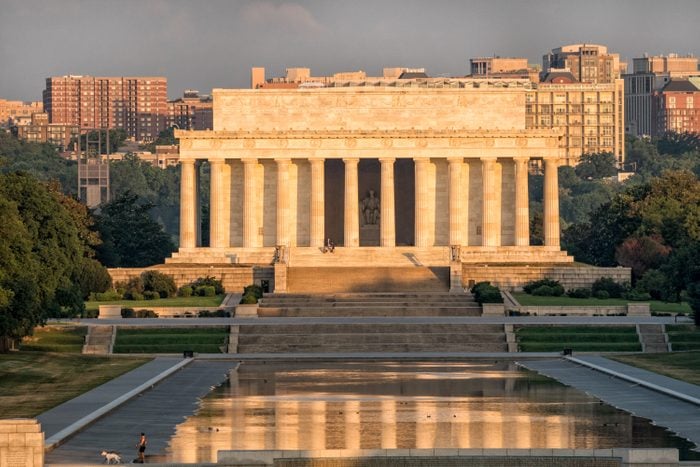
The Lincoln Memorial
Washington, D.C., has many beautiful structures dedicated to the United States government and its history, including the White House, the Capitol Building, and the Washington Monument. But perhaps the most moving of all is the Lincoln Memorial, with its huge statue of one of the greatest presidents ever, Abraham Lincoln. The immense marble statue has the effect of making those who look upon it feel extreme reverence for our nation—and the president who brought America through the Civil War. Lincoln’s famous Gettysburg Address is inscribed on the wall, and across from the open-air columns, down the steps from which Martin Luther King Jr. gave his famous “I Have a Dream” speech, there’s a gorgeous view along with the reflecting pool to the Washington Monument. Washington, D.C., is one of America’s most beautiful places in the spring.
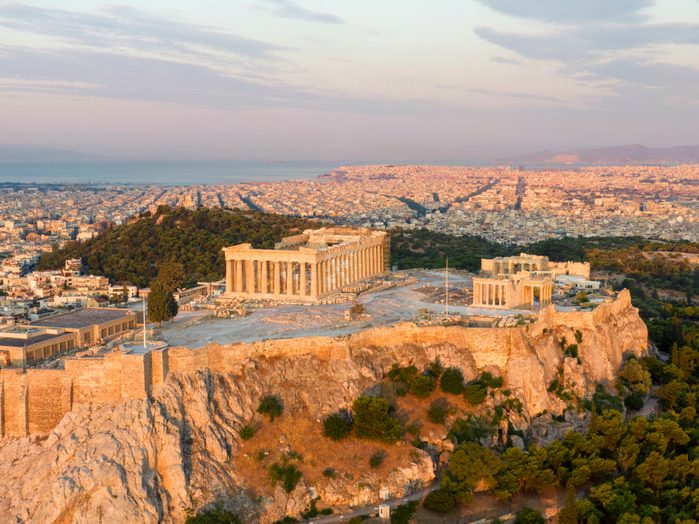
The Parthenon
The creators of the Lincoln Memorial were inspired by ancient Greek temples such as the Parthenon. This iconic Greek structure stands on the Acropolis, a rocky mount and natural fortress high in the center of Athens, making the temple visible from across the surrounding city. Even though it’s in ruins, the power of this temple to mystify those who look upon it remains. Built around 440 BC, this building dedicated to Athena, the goddess of war and wisdom, is made of marble and decorated with statues and reliefs of gods and battles. One collection of the Parthenon’s statues were removed and taken to the British Museum; called the Elgin marbles, the subject of their return is an ongoing debate today.
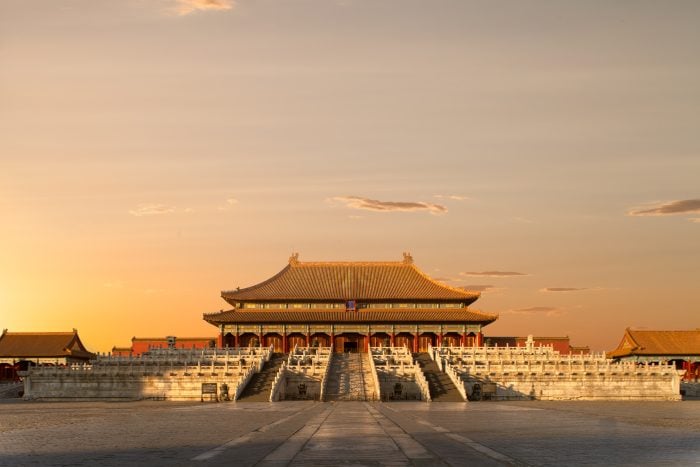
The Forbidden City
This ominously named royal palace complex in Beijing is an outstanding marvel of Chinese architecture in all its detail and vibrancy. Completed in 1420, the Forbidden City is actually made of many buildings surrounded by a two-mile-long wall and a moat. It’s gorgeously decorated mainly in yellow and red, with colorful elements, mythical animals, and distinctly shaped swooping roofs. Because the emperor was considered to be a “son of heaven,” regular people were not let in, which is why it was considered “forbidden.” At the center of the Forbidden City is its largest building, the Hall of Supreme Harmony, which contains the throne, atop three-tiered marble terraces; beyond are the royal residences.
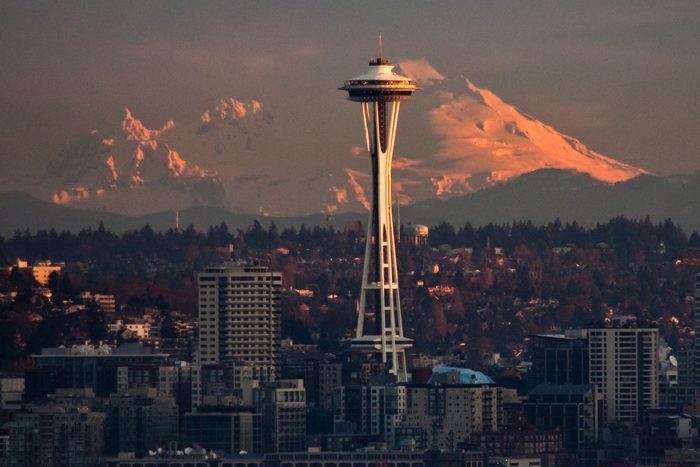
The Space Needle
Embracing futuristic beauty with a mid-century modern flair, Seattle’s Space Needle was built for the 1962 World’s Fair to celebrate the “age of space” theme and represent innovation. At the pinnacle of the 605-foot landmark, a flying saucer-like “top house” looks like something out of The Jetsons; you can see the view from a live, rotating webcam on the Space Needle’s website. It almost looks top-heavy—a comedy show’s 1989 April Fools’ prank had people believing the needle had fallen over—but its sleek tripod legs actually balance it out. The top house is enclosed in glass, and it features the world’s only revolving glass floor.
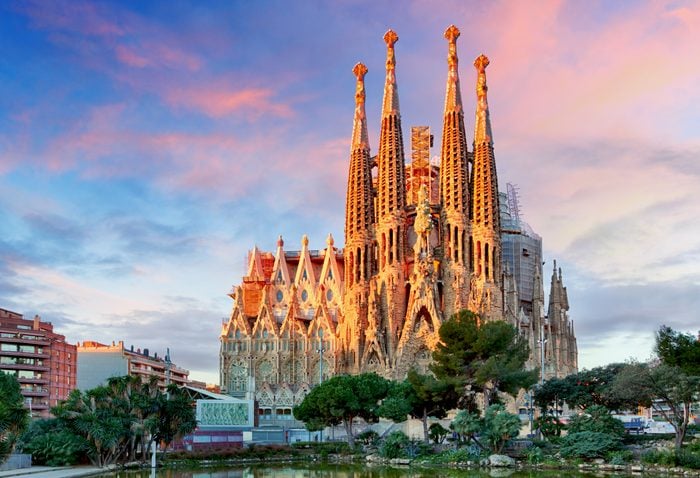
La Sagrada Família
Barcelona is well-known for the distinctive architecture of the city’s favorite son, Antoni Gaudi. His style defies description, all curves, colors, and textures that look at once as the work of a master as well as something a child molded out of Play-Doh. His most outlandishly beautiful creation is La Sagrada Família, a church he began in 1882 and which is still being built—construction is expected to be finally completed in 2026. Appearing almost like a drip sandcastle, the church features many tall spires and points along the roof, and it’s adorned with stone and plaster sculptures and details, as well as colorful pinnacles. La Sagrada Família also boasts some of the most stunning stained glass windows in the world.
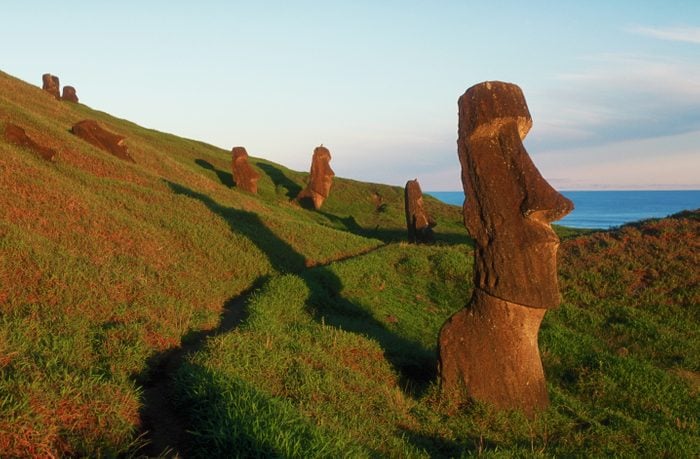
Moai of Easter Island
These giant heads are also completely unique, with no equal anywhere on Earth. Nearly 1,000 of the statues stand sentinel across Easter Island (also called Rapa Nui) in the Pacific Ocean, reflecting a solemn beauty with their long, wide noses, strong chins, and mouths set in a seemingly determined position. Called moai, the sculptures were made by Polynesians between 1400 and 1650 using volcanic rock from a local quarry. But at an average of around 15 feet tall and more than 90 tons, it’s not quite known how the megaliths were moved around the island. And while we think of them as “heads,” there is evidence that they have bodies below ground, as some archaeologists have discovered. Mysterious and magnificent, the simple yet sublime design of the moai is captivating.
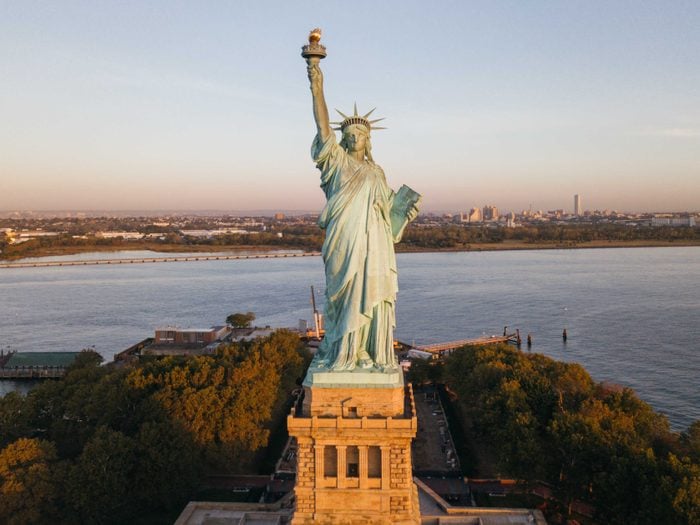
The Statue of Liberty
A statue of another sort has greeted visitors and immigrants to New York Harbor for more than 100 years. A gift from France in 1886 (fun fact: there’s a mini Statue of Liberty in Paris, as well), the neoclassical Lady Liberty wears flowing robes and a crown, and holds a torch and a tablet reading “JULY IV MDCCLXXVI,” which is, of course, July 4, 1776. Standing 305 feet including the pedestal, she’s made out of copper, which turned into her distinctive green hue as she was exposed to air, but she was the color of a penny upon her unveiling. Although she’s artistically beautiful, her appeal is also in her symbolism of freedom for Americans and those who have come here looking for a better life. In fact, her full name is “Statue of Liberty Enlightening the World.” Here are more facts you probably didn’t know about the Statue of Liberty.
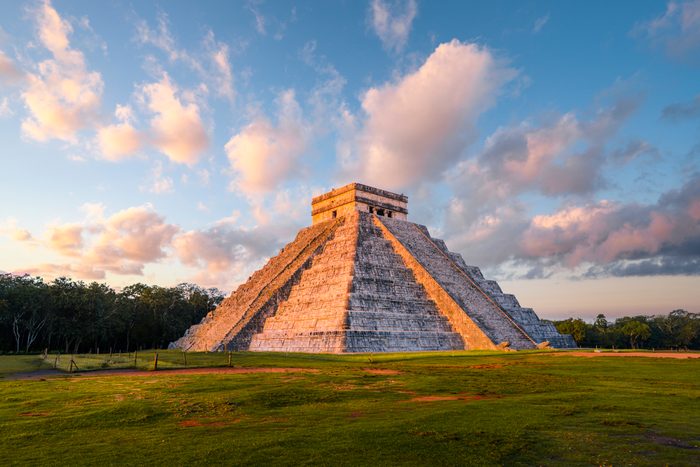
Chichen Itza
The most astounding pre-Hispanic structure of Mesoamerica stands in Mexico’s Yucatán peninsula: the huge stepped pyramid called “the Castle” or “Temple of Kukulkan” in the ancient ruins of Chichen Itza. The city was established by the Mayans and then taken over by another group called the Toltecs, at which time the most impressive structures at Chichen Itza were built around 900 AD. Named for the Mayan god Kukulkan, a feathered serpent, the central structure is nearly 100 feet tall and has 91 steps on each of its four sides. The beauty in its design involves the builders’ precise knowledge of math and astronomy: The temple is aligned with the sun, so on the spring and fall equinoxes, the shadow of a serpent seems to crawl down the pyramid.
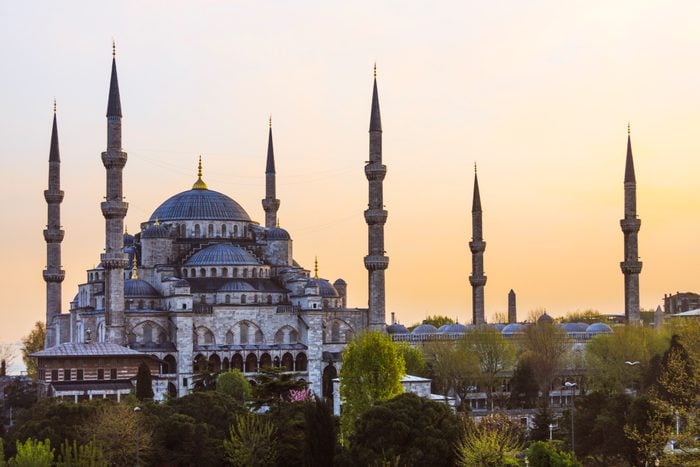
The Blue Mosque
Istanbul, Turkey, has so many beautiful places of worship, and some might say the most beautiful is a toss-up between the church turned museum Hagia Sophia and the Blue Mosque. They’re both similar in design, but we’re choosing the Blue Mosque because of its refinement and detail, with its six graceful minarets, one main and eight smaller domes, and gorgeous stained glass. The mosque’s crowning achievement, though, is 20,000 ceramic “Iznik” tiles in bright blue, green, and turquoise embellishing the interior, which give the mosque its nickname. Reds and yellows, along with gold calligraphy, complete the decorations, forming patterns, geometric bands, and medallions; motifs include flowers, fruit, and cypress trees. Built-in 1616, it’s officially called the Sultan Ahmed Mosque after the ruler who commissioned it. Istanbul is also the only city in the world that straddles two continents.
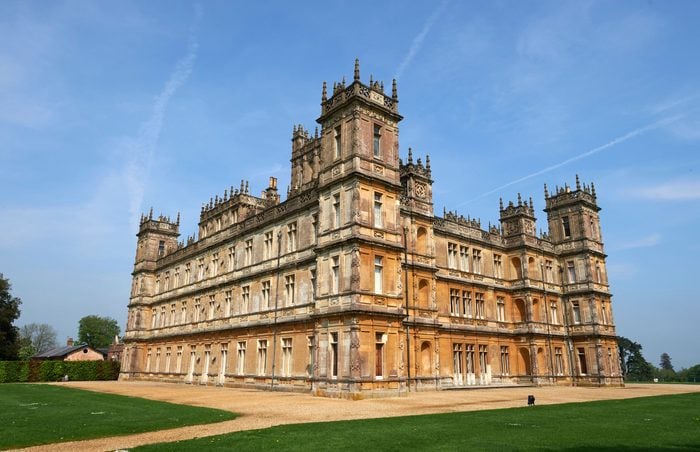
Highclere Castle
Better known as the titular location for Downton Abbey, the real English manor home is one of the most beautiful in Britain—and there are plenty to choose from. The site has been occupied by the Earls of Carnarvon since the 17th century, but the current castle dates from the Victorian period. Highclere Castle‘s almost-square design (it’s not quite symmetrical) features a central tower, with four additional towers at each corner, and it’s the spires on the towers and along the roof that give the castle its lofty appearance. The interior lives up to its stately exterior: The “saloon” boasts a three-story, 50-foot ceiling with skylights, surrounded by a second-floor gallery reached by an ornate oak staircase.
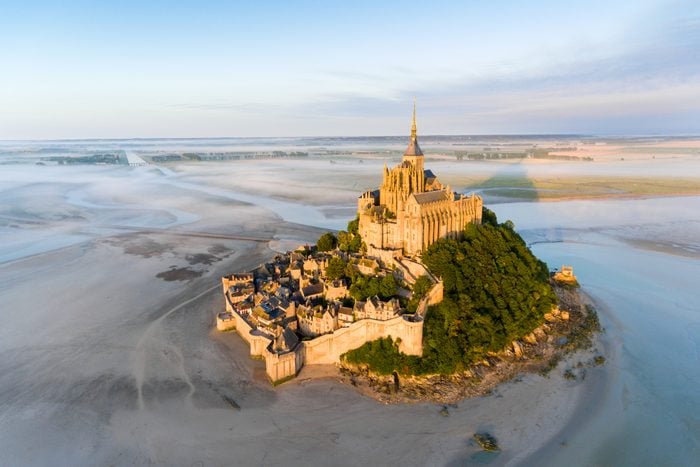
Mont-Saint-Michel
Although it’s also lovely up close, what sets this monastery apart is the breathtaking view from afar. Just off the northern shore of France in Normandy, Mont-Saint-Michel sits atop a small but steep outcropping on a tiny island. On a misty day, it seems to float above the clouds, the abbey’s spire rising to the heavens. At high tide, the island is surrounded by water; at low tide, a pathway of sand leads to the village below. The uncertainty of the abbey’s surroundings must have lent a sense of danger and mystery to the monastery when it was built in the Middle Ages—and its mystique lingers even today. Indulge your wanderlust with these 50 jaw-dropping photos of the world’s most beautiful countries.
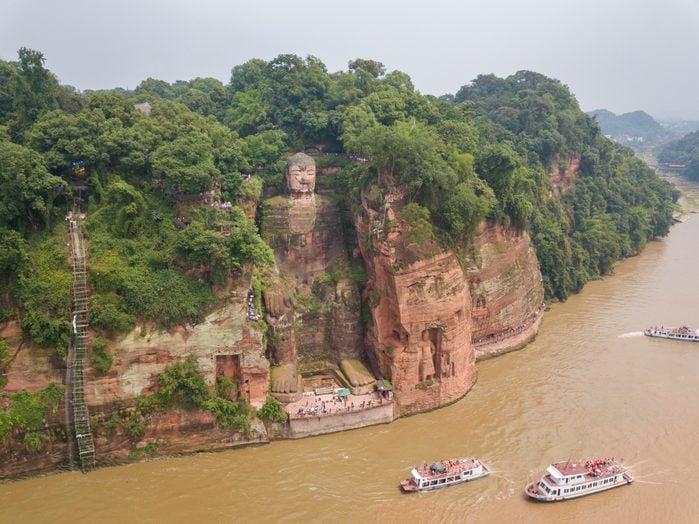
Giant Buddha of Leshan
On Mount Emei, the first center of Buddhism in China sits this remarkable 232-foot-tall Buddha, carved out of the red sandstone rock in the 8th century. Located in the Mount Emei Scenic Area of protected natural beauty, the Buddha—the largest ancient Buddha in the world—is also partially covered by green vegetation, making it look like he’s wearing the forest. Meticulously crafted, his serene face looks out at the meeting of three rivers. In addition, his hair features more than 1,000 buns, and his long ears are made of wood covered in mud to adhere to the rest of the stone head. Unseen is the sophisticated drainage system that has prevented the Buddha from deteriorating due to rain.
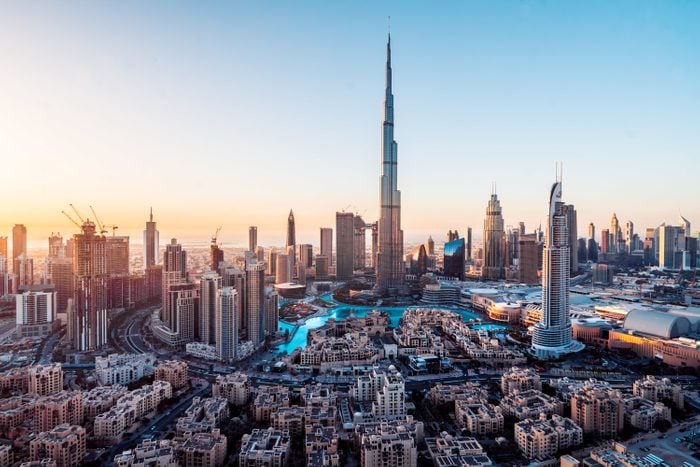
Burj Khalifa
From the ancient to the very modern, this high-tech yet exquisite building in Dubai is the current tallest in the world at over 2,700 feet. Its series of slender cylinders seem to spiral to the sky, ending in a needle-like point. Opened in 2010, the Burj Khalifa sparkles and gleams thanks to reflective glazing and nearly 26,000 hand-cut glass panels that comprise the exterior. The building’s sophisticated but subtle beauty might be due to being inspired by nature: The shape of the hymenocallis, or spider lily, a desert flower of the region, was the basis for its floor plan. Here are more of the tallest skyscrapers in the world.
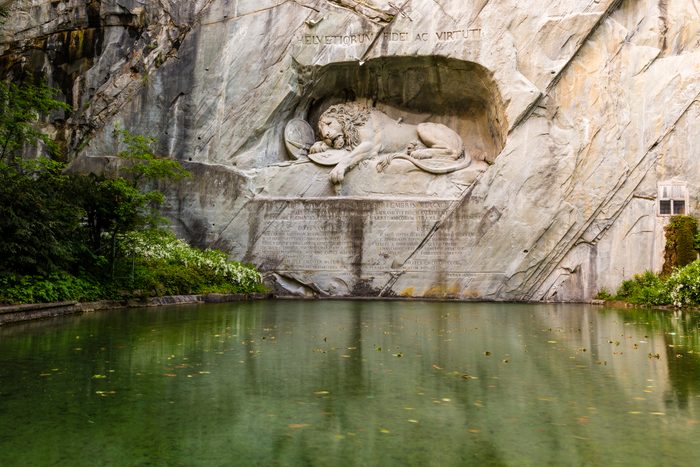
The Lion of Lucerne
This tragically beautiful monument in Lucerne, Switzerland, remembers Swiss soldiers who lost their lives in the French Revolution. Carved into a sandstone rock face, a dying lion with a spear in its side perishes in front of our eyes, like the brave men it represents, above a serene pool of water. Created in 1821, the sculpture is 20 feet high and 33 feet across, with the Latin inscription Helvetiorum Fidei Ac Virtuti, “to the loyalty and bravery of the Swiss.” It left such an impression on Mark Twain that he called it “the most mournful and moving piece of stone in the world,” and so it remains today.
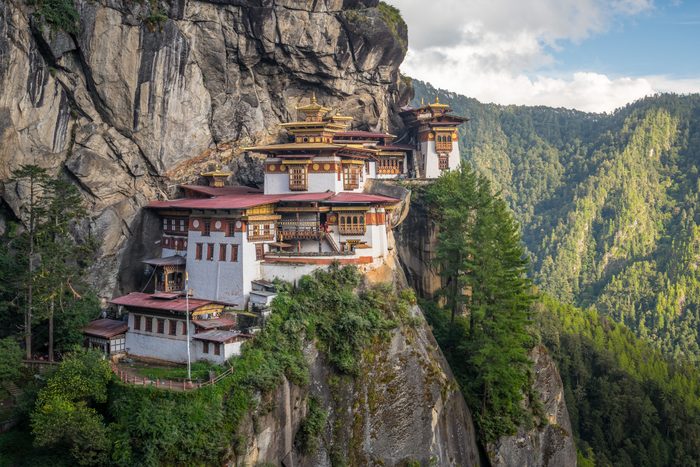
Paro Taktsang (Tiger’s Nest)
This monastery high in the Himalayan mountains of Bhutan defies gravity. Its imaginative name of “Tiger’s Nest” evokes a dangerous yet secure hideaway—which is exactly what it is. The name actually refers to the legend of the Buddhist master Guru Padmasambhava, who is said to have found the site by flying there on the back of a tiger. Built-in 1692 against the side of a cliff nearly 3,000 feet above the valley below, the Buddhist temples are layered above one another and stand out from the rock in a colorful mix of white, red, and gold. The current structures, however, are not the original: After it burned in a fire in 1998, the important spiritual and cultural site was rebuilt.
